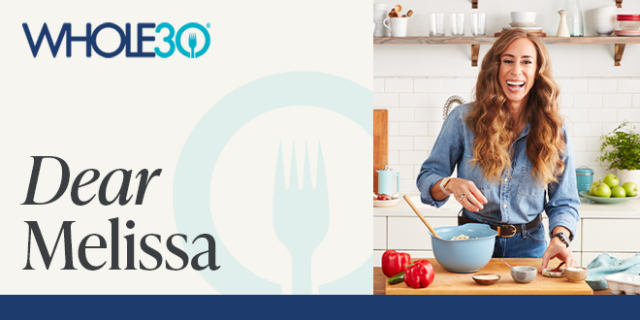I was listening to an NPR report today that was talking about how, as we are all stuck at home and engulfed in the news cycle, we’re acutely aware of every sniffle, cough, ache, and pain. This period has made us hyper-aware of our bodies, steeped in COVID-19 cases and symptoms.
So when a Whole30 veteran sent me a DM saying, “You might want to warn people new to the Whole30 about what the first week can be like, so they don’t think they’ve got the virus,” I immediately saw her point.
As our Whole30 Timeline shares, the first few days (or perhaps week) of the Whole30 can be rough, especially if you’re coming to us from a S.A.D. (Standard American Diet). Even if you normally eat a Whole30-ish or Paleo approach, if you’ve been front row at Sugar-pa-looza in the face of so much stress and uncertainty, it could also be a rough ride.
In this context, your body has become accustomed to running on sugar for energy, and your brain has become used to reward after reward any time stress, anxiety, or boredom demands it. Taking all of that away at once (no bread, no wine, no chocolate, no cookies) can lead to a few days of not-so-fun feelings, like lethargy, crankiness, and headaches.
Some call this period the “carb flu,” but given what we know about this pandemic, that moniker is highly inaccurate. While it’s true that your first week of Whole30 can leave you feeling run-down, tired, and generally kind of poopy, it’s nothing like the actual flu, and doesn’t have much of an overlap with Coronavirus symptoms.
You might also like: Is this Normal? A Guide to Whole30 “Symptoms”
Coronavirus vs. Dietary Changes
What you might expect at the beginning of your Whole30 (particularly Days 2 – 7):
- Lethargy; you drag yourself out of bed, slump mid-afternoon, and don’t have much energy for a workout.
- Headaches, as your body gets used to being cut off from sugar. (This is especially true if leaving out the sugar means you’re drinking less coffee too.)
- Crankiness, as your cravings roar and you realize how truly dependent you are on your sweets and treats.
- Lack of focus, because you’re tired and distracted by your cravings
- Digestive distress (rare). Some experience diarrhea or constipation, particularly if you start adding a ton of raw veggies and fruit to your diet all of a sudden. This typically wouldn’t show up until Week 2, however, and isn’t accompanied by stomach pain, nausea, cramps, or vomiting.
According to the CDC and WHO, the most common symptoms of Coronavirus include:
- Fever
- Dry cough
- Shortness of breath
- Tiredness
As you can see, there isn’t a ton of overlap here, besides feeling tired. (According to the WHO, you may also experience headaches with COVID-19, but it’s not one of the most common symptoms.)
Here’s what Rick Henriksen, MD (and also a Whole30 Certified Coach), advises:
During this pandemic, more than ever, making heathy food choices are one of the keys to a strong immune system. In the first few days of the Whole30, many of my patients experience symptoms that come from consuming a lower amount of processed carbohydrates and sugar. Feeling tired, grumpy, and low energy are very common during this time frame as your body is re-learning how to use fat (rather than sugar) for energy.
Most folks, including me and my patients, are currently hyper-aware of abnormal symptoms that could potentially be related to COVID-19. Your anxiety may tempt you into thinking that your low energy and grumpiness could be an early sign of the viral infection, but these mild symptoms can be from your dietary change.
If in doubt, please contact your local public health department or your personal physician. They will be help you decide if testing is appropriate. Please let them know that you have recently change your dietary habits, so they can get the full picture.
As you can see from this chart, most of common symptoms of COVID-19 are NOT COMMON with starting a Whole30. You should not get a fever, cough, shortness of breath or a sore throat during your Whole30. If you feel these symptoms, you should immediately contact your health care provider.
If you have time to prep…
For those of you not already on the program but thinking of starting a Whole30, there are some things you can do NOW to mitigate the severity of your sugar-and-carb crash.
- Start cutting back on sugar now. Generally, this is harder than doing no added sugar on a Whole30, because your brain will constantly be trying to negotiate “just one more.” If it helps, set some rules around consumption that will help you slow your roll, like no added sugar after dinner, or no more buying (insert food-with-no-brakes).
- If you’re planning to use the Whole30 to cut back on caffeine, start that now too, but ease into it. Try either drinking half a cup less than normal, or filling your cup three-quarters and adding decaf for the other quarter. Switching your normal second (or third) cup for an adaptagenic tea or coffee alternative (like MUD/WTR or Four Sigmatic) can help you maintain productivity with less caffeine. These actions now will help you avoid a caffeine crash, which can also feel like the flu.
- Schedule recovery movements, half-intensity workouts, or a mobility focus for your first week on the Whole30. This way, if you are super-tired, you aren’t beating yourself up for not completing your normally challenging workout. Focus on walks, restorative online yoga classes, technique work, or low-impact workouts.
- Prioritize sleep now, so you enter into your Whole30 well-rested. That way even if you do become lethargic as a result of cutting back on sugar, you’re not completely zonked out.
In summary…
I know this is a challenging and scary time for all of us, and your return to the Whole30 is an attempt to reground, build a solid foundation for stress management, and fuel your body from a place of self-care. My last tip to stay calm and present during your Whole30 during this time period is to stay connected. Often that anxiety and fear grows in isolation, so reach out and talk to someone—a friend, family member, your mental health care provider, or the Whole30 HQ team—about how you’re feeling and how you’re doing on the program.
We’re all here for you, and just knowing that might help ease those Day 3 crankies.
XO Melissa
















